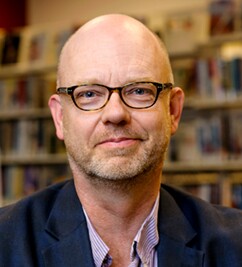WIDA, the consortium most educators may know for its language-proficiency test used for identifying English learners in close to 40 states, is moving more into professional development programming for all teachers who work with English learners—including those in general education classrooms.
The organization hired Meg Van Voorhis for a new role called chief educator learning officer late last year to improve on outreach to teachers and online support for how to best teach the nation’s growing English learner population. Voorhis is also tasked with overseeing WIDA Español, a program offering standards for instruction in Spanish.
Researchers point to a growing need for building general education teachers’ skills in working with English learners. The U.S. Department of Education’s office of English language acquisition is also looking into professional development to address this skill gap.
Van Voorhis and Timothy Boals, the founder and director of WIDA, spoke with Education Week about why they saw a need for the new position and what educators can expect from the organization moving forward. This interview has been edited for length and clarity.
Why create this role at WIDA?
Tim Boals: From the very beginning of our organization, 20 years ago, we wanted to be about more than just a language-proficiency test. As important as that is, we really wanted to provide a system of support for teachers of multilingual learners. And we feel that teachers need support in understanding the role of standards, the role of assessments in informing their instruction, and really helping them to understand what they can do more of within their classroom so that multilingual learners can be successful in both learning English and in succeeding in school.
But things have changed a lot over the years, from the early days, when we had face-to-face professional learning and PDF articles on our website. We have begun moving in much more sophisticated ways toward support for teachers online, multimedia opportunities that really respond to teachers’ needs. This [chief educator learning officer] position really helps take all of that to the next level for us. I think in fundamental ways, the shift has been toward whole school approaches, helping mainstream classroom teachers understand what multilingual learners need just as much as the [English-as-a-second-language] and bilingual teachers. And those are shifts that bringing in Meg and creating this position, we think will help us do an even better job of reaching more educators more deeply with the information, knowledge, and skills development that they need to do a better job with their multilingual learners.

Has WIDA invested in educator professional development before?
Boals: We always have invested a certain percentage of our revenue into professional learning and resources for teachers because we really believe that that is a fundamental part of our mission. However, we recognize, and I think our state partners recognize, that the key to more successful learning is in reaching our educators. So we very much are committed with this new role to upping our game. I think the WIDA Español program is a case in point. We’re spending more funding there because we look at the research that says teachers understanding the role of the native language and culture in the education of multilingual learners is key to their success in U.S. schools.
What are some priorities for the new role heading into this year?
Meg Van Voorhis: One thing that’s really important to drive home is that there are a lot of amazing things already happening with professional learning at WIDA. And so what I see as my initial priority is to capitalize on what’s already working and kind of build on the foundation. There are amazing workshops that I’ve had a chance to sit in on, there’s also the self-paced online learning that we offer. But I think that one of the big goals is just to really make sure that we’re clearly articulating those offerings and who they’re for.
So how are we personalizing those offerings, making sure we’re really hitting the needs of content-area teachers, for example, in addition to those specialists? How are we bringing WIDA Español more intentionally into the fold so that it’s integrated into all that we’re doing?
I think another piece is just having a cohesive ecosystem of offerings. So that when we’re talking about our [WIDA annual] conference, or we’re talking about our online courses, or we’re talking about those in-person workshops, that there’s sort of a clear pathway for the learners who are going in and diving in. Where on the road map do I start, based on my role or based on my background knowledge? And how do we create an intentional community of learners because that’s one of the things that’s always so challenging about online learning is that it can be isolating. So how are we helping educators bring it back to practice and creating those bite-sized opportunities for them to dive into some complex concepts? We have a hugely robust research base, but sometimes it’s also important to break it down so that educators can find support for what they’re learning.

The federal office overseeing English learners is also investing in professional development. Are you excited to capitalize on that?
Van Voorhis: I think it gives us an opportunity to really think holistically about that professional learning landscape and how WIDA fits in it. And it is really an opportunity to expand our reach and how we talk about supporting multilingual learners. It’s not just a pocket, WIDA has a very unique space to do that. But I think having the support of a broader network is going to be really crucial as we start to innovate and make some of these changes.
Can you share more about the future of WIDA Español?
Boals: Probably around 2007, we developed, with the help of Chicago public schools and Milwaukee public schools, a set of Spanish content standards. And I believe the language standards came after that. Maybe four years ago [led by Sam Aguirre], we really started developing a new suite of materials that’s much more current. We always did have some resources in this area; I just don’t think we’ve been able to do as much as I would have liked to in the past.
Van Voorhis: As we think about even just the way that we design our offerings, my hope is that as we bring WIDA Español more into the fold under this new team, there’s a shared approach to developing our resources as we think about the standards. What are those key ideas that really cut across all standards? And how do we use those key ideas to really drive the creation of our professional learning resources? We will still have resources that are unique to WIDA Español. But we also are going to be integrating some of those resources more intentionally into the workshops that we have, into the online learning that we offer to other teachers. So that we’re not just seeing WIDA Español as an offering that can only support language teachers or dual-language teachers. There’s actually a piece of it that can cut across all of our professional learning.
Boals: We do also hope in the future to begin looking at classroom assessments, and I think those have implications both for WIDA Español and for the English-language development side of the house, because we would see those classroom assessments as being flexible models for teachers to look at. So that they can more easily get a handle on the progress they see their students making in whatever language. In the early days, when I was in the field and going out a lot to school classrooms, teachers would say to me, “I just don’t know how to figure out whether my students are growing the way they should or not, both in their language and in their content development.” So [we’re] helping them have the tools that they need to really get a handle on what they’re seeing within the classroom and making those tools easy to use.









